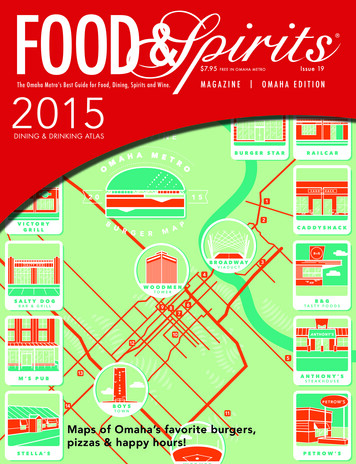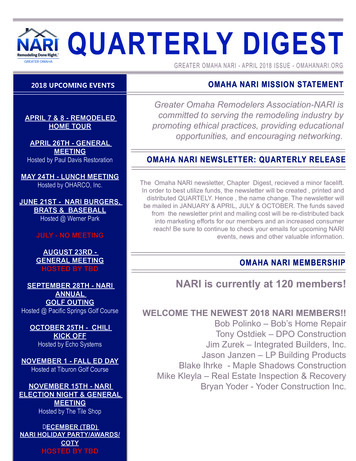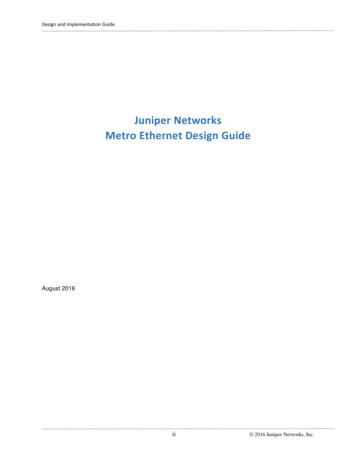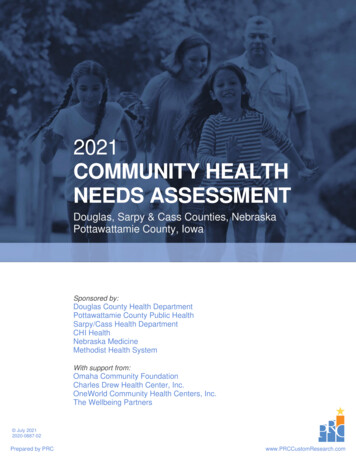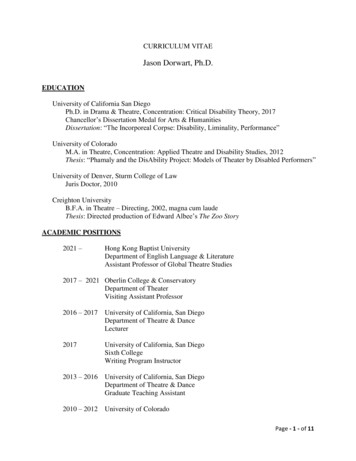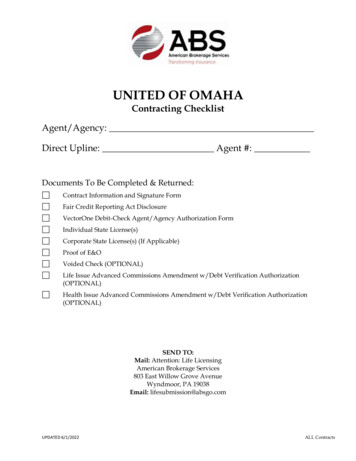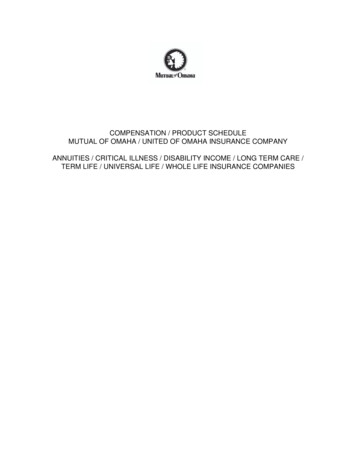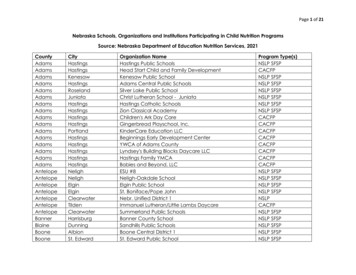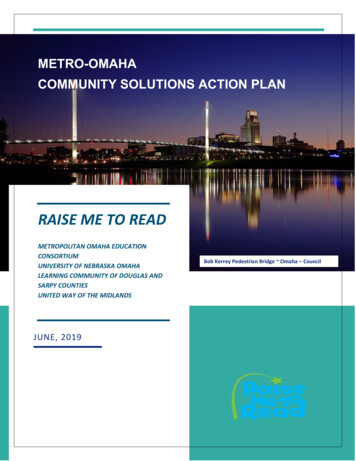
Transcription
METRO-OMAHACOMMUNITY SOLUTIONS ACTION PLANRAISE ME TO READMETROPOLITAN OMAHA EDUCATIONCONSORTIUMUNIVERSITY OF NEBRASKA OMAHALEARNING COMMUNITY OF DOUGLAS ANDSARPY COUNTIESUNITED WAY OF THE MIDLANDSBob Kerrey Pedestrian Bridge Omaha – CouncilJUNE, 20191
Table of ContentsPagePrefaceSystems Leadership4Collective Impact6Fundamentals9Circle of Influence12Building Ourselves Out of the StoryBackbone14Local Control15Collaboration16Metropolitan HistoryOmaha “The Upstream People”17Development18Population19A Thriving Community20Business/Philanthropy22Executive Summary23Foundation and Pillars27Foundation: Overlapping and Interlaced Strands of Support28Pillar I Early LiteracyKindergarten Readiness30Summer/Extended Learning38Trauma/Adverse Experiences40Pillar II Third Grade Literacy44Pillar III Culture of Showing Up - School Attendance462
Timeline50Prologue51Task Force Members52Definitions (for the purpose of this plan)54Citations563
PrefaceSystems LeadershipThis plan has been created for the Metro-Omaha area by the backbone organization, theMetropolitan Omaha Education Consortium (MOEC). MOEC is a collaborative organization dedicatedto public education and bringing Omaha-area educators together to meet education commitments.An endeavor of such magnitude as a Community Solutions Action Plan (CSAP) requires considerationof the larger system (Senge, et al., 2015, p. 28-29), including schools, organizations, philanthropicefforts, communities, and the families which reside within them. With this plan, MOEC hopes to“embody an ancient understanding of leadership; the Indo-European root of ‘to lead’ literally meansto step across a threshold” (Senge, et al., 2015, p. 28).In order for this step across the threshold to be truly effective, it requires one to first “see the field”.A rich and thriving network of family and literacy support already exists in our Metro-Omaha area.The original work for this plan included: Sensing – investigation and evaluation of existing entities andinitiatives supporting schools and families, stakeholder reports and state and local school districtdata; Presencing – study, reflection, conclusions, and conversations about possible actions; andRealizing – acting on the information in order to create a plan which is meaningful and acts in theword, instead of “on the world” (Senge, 2015, p. 87).“This is the true joy in life, the being used for a purpose you consider a mighty one,the being a force of nature.” George Bernard ShawOften in conversations with partners and allies, “intersectionality,” “timing,” and “convergence” havebeen voiced or become evident. With multiple initiatives already engaged in our area, the Campaignfor Grade Level Reading plan has no need or wish to duplicate efforts. Our partners, The LearningCommunity of Douglas and Sarpy County (TLC), The United Way of the Midlands (UWM), The BuffettEarly Childhood Institute (BECI), and the University of Nebraska Omaha (UNO) are already engaged inall aspects of the assurances – as is the backbone organization, MOEC – with professionaldevelopment, shared resources, working groups, and ongoing collaboration within its consortiummembers. Additionally, the allies are deeply involved in family supports, outreach and instruction. Itis MOEC’s intention, then, that a system level perspective will allow us to evaluate next stepstogether.Following research and planning, a task force was created and invited to participate in an advisorycapacity for both the Council Bluffs and Metro-Omaha campaigns. It is essential to note here that theCouncil Bluffs, IA Raise Me to Read Campaign for Grade Level Reading is in its sixth year, and hasprovided resources and events for families in the Council Bluffs area in the campaign categories of4
school readiness, summer learning and attendance. Throughout its existence, Raise Me to Read hasbeen working closely with the Council Bluffs Community School District, the United Way of theMidlands and the Iowa West Foundation. Council Bluffs and Omaha – and surrounding communities– are in the same general area, with the Missouri River dividing state and city lines, thus continuity ofname and messaging makes common sense. The Metro-Omaha GLR campaign has the fortunateadvantage of learning from the expertise of the Council Bluffs Raise Me to Read GLR initiative.At the convening of MOEC’s duo-state task force (a group comprised of experts from each of thecampaign areas, and including public health), deep listening and shared reflection was evident. It isthrough such continued conversation that trust will be fostered between the entities, andappreciation gained regarding individual situations. Members reflected in small, rotating groups,suggesting key issues and circumstance connected to each of the CSAP assurances. Task forcemembers also determined additional vital individuals and entities who/which should be involved.When defining “the problem,” the task force members noted that a myriad of family issues includingsocio-economic status, adverse childhood/generational experiences, limited access to books andstimulating well-rounded activities, and lack of community supports result in learning andachievement gaps. There was keen awareness that some families may not understand theimportance of early learning or how to engage with their children from infancy onward, and that thismay be a result of their own trauma and learning abilities. One individual noted succinctly, “We aretrying to create a world where children, no matter their resources, may live and learn in a literacyrich environment within supportive communities.”It has often been the practice of schools and other support systems to react to needs. This is amarvelously humane act, and it assists the person or problem in the moment, but it does not changethe existence of the problem. Within a systems framework, one must, instead, respond. It isnecessary to set goals which thoroughly and thoughtfully plan for that which will effect change.“Continuing to do what we are currently doing but doing it harder or smarter is not likely to producevery different outcomes. Real change starts with recognizing that we are part of the systems we seekto change” (Senge et al., 2015, p. 29). Our task force members suggested “mapping efforts,” and“connecting the dots” in addition to leveraging to greater effect activities which are alreadyoccurring. Actor mapping has thus become an important foundational aspect of our plan as weexplore the relationships and connections among actors and their links to our initiatives of familysupport, community conversation and early literacy. It is essential that efforts are managed so thatthe essence of the work is not merely assisting with survival, but is also giving families the skills andsupports to thrive (Pankoke, 2015, p. 19). Plans will include responses for the future, with the hope ofbecoming inspired by what is possible.5
Collective ImpactA distinctive feature of the plan will be the consideration of the initiative as one of communityengagement. Thoughtful engagement “of the people whose lives are most directly and deeplyaffected” by the problem of grade level reading is essential (Preskill, 2014). As research continues toprovide evidence regarding the significance of children’s earliest learnings and habits, it is understoodthat the future of the children in our community does not rest merely on the shoulder of schools, nordoes it rest only in family homes. In order to elicit the transformation imagined, “strong programs”are not necessary (though they will be helpful); what is needed is “strong community, the onlychange that is truly sustainable” (Schmitz, 2017, p. 6).Position yourself for what is coming SengeSustainable change involves an asset-based mindset. “Rather than begin by defining people andcommunities by their deficits [or in some cases, by their ‘zip codes’ – as is the commonnomenclature] and trying to fix them, you discover their assets (experience, knowledge, skills, talents,passions, and relationships) and engage them” (Schmitz, 2017, p. 6). An essential element in thiscollective impact amalgam is to consider our work as one of being active in the community, asopposed to doing to or for the community. This problem solving approach will include the Five CoreConditions of collective impact, including a common agenda, continuous communication, sharedmeasurement system, mutually reinforcing activities, and the backbone function as demonstrated inthe visual below from Stanford Information Review (Preskill, et al., 2014, p. 4):The common agenda has already included, and will continue to include, conversation with manyothers about the “problem” of grade level reading and what can be achieved together in response.Even as this is being written, our core team members are reaching out to those individuals and6
entities working in the community and schools in order to establish an ongoing dialogue and, further,to enable us to meet the families where they are, continuing the conversation “on-the-ground”.Unceasing communication will occur in the realms of personal outreach, and of press and socialmedia. Shared media in both the Council Bluffs and Metro-Omaha community is a signature aspectof the cross-state collaboration, and one reason we share the moniker of “Raise Me to Read”.Messaging will include initiatives and activities in our metro area as well as the push of informationregarding literacy, public health, extended learning opportunities and attendance. While focus is onthe immediate community, there are many initiatives from which to learn that are a part of theCampaign for Grade Level Reading, or connected with Attendance Works, as well as from those whoare working on educational and social-emotional initiatives around the globe. Valuable informationwill come from such groups as Boston Basics, Zero to Three, The Harvard Center on the DevelopingChild, The National Black Child Development Institute (NBCDI), ACE’s Connection, First 2000 Daysfrom Canada, The Green String Network in Africa, and ACE’s Scotland Forum, and the newly formingSuccess Starts Small from the Prosper Lincoln (Nebraska) initiative, as well as others.Work regarding a shared measurement system is wrought with hazards. For good reason, thoseworking in education often consider shared measurement to mean comparisons and rankings. That isthe unfortunate byproduct of state testing. What MOEC considers important is agreement betweenthe many school districts in our area on a few measures for the purpose of considering growth orimprovement, and not for comparison of one district to another.Our partners and allies use shared information, measures, and reports such as: Kids Count in Nebraska Report State Department of Education’s Nebraska Education Profile 2018 Community Health Needs Assessment Report The Youngest Nebraskans: A Statistical Look at Infants and Toddlers in Nebraska Raising the Next Nebraskans Their Future, Our Future Community Report United States Census Bureau Learning Community of Douglas and Sarpy Counties Annual Plan Evaluation and CommunityReport Buffett Early Childhood Institute ReportsIn April, 2018, Nebraska Governor Pete Rickets signed the Legislature’s Nebraska Reading andImprovement Act, taking effect in the coming (2019-2020) school year. Nebraska State Senator LouAnn Linehan noted, “Early literacy is the foundation for academic success,” adding that “the power ofreading opens doors that lead to fulfilling careers and richer understanding of the world around us”(ExcelinEd, 2018). With the effective date of August 2019, this new act may provide an opportunityfor shared literacy measure because the separate districts may choose to adopt the same assessment7
(possibly NWEA’s MAP ) for this newly-required reading assessment and reporting. This could lead toa cohesive understanding of the proficiency and needs of our students.The MOEC Strategic Work Group for Attendance and the School Based Attendance Committee (SBAC)also have concluded together that a focus on chronic absenteeism is the most effective measure toconsider. What constitutes an “absence” is not uniform throughout the districts, though anagreement of the percentage of time missed as being considered “chronic” has been reached. Bothentities are in ongoing conversation in order to eliminate duplication of efforts.All of the mutually reinforcing activities which may occur as this initiative moves from informing toconsulting, to collaborating with the community cannot at present be fully conceived. However, it isenvisioned that the work will include: Support of partners, allies, and stakeholders in the work that has begun.Employment of actor mapping in order to understand what is missing or requiresenhancement.Consideration of additional collaboration with, and identification of, new allies existing in theCommunity Engagement Center at UNO, and elsewhere throughout the entire community.Changing the trajectory for children and families in our community by successfully creating agenerational knowledge regarding literacy, and by encouraging discussion (out-loud andoften) in all community spaces regarding the importance of communicating and engaging withchildren from birth.Ensuring that businesses and entities increase their understanding of the importance ofliteracy, and that all support organizations include providing literacy information to families asa natural and holistic approach for increasing a child’s success in life.Being present consistently and continuously in the community until true progress has beenmade, effectively “working ourselves out of a job”.Community engagement must be “result-driven and purposeful” (Schmitz, 2017). Using theCommunity Engagement Toolkit (Schmitz, 2017), MOEC provides answers to these two questions:Why is community engagement important to your Initiative? How will it contribute to your results?Community Engagement is Important Because: Meaningful change occurs from the individual outward toward society. Parents, families and neighbors cannot merely be told to read more to-and with children. Engagement, enlightenment and family supports are necessary aspects. If the habits and understandings of families are changed, then everything else is possible.8
Community Engagement Will Contribute to Results By: Fostering improved understanding of the importance of grade level reading. Creating changed perceptions as to communicating with and reading to children from birth. Enhancing support for more calm and cared-for families. Contributing to society by reduction of delinquency and drop-outs due to improved literacy. Creating a community of ambassadors who spread the message about grade level readingfrom generation to generation.FundamentalsThe great lesson is that the sacred is in the ordinary, that it is to be found inone’s daily life, in one’s neighbors, friends, and family, in one’s backyard. Abraham MaslowDuring the creation of this plan, and no matter what issue was being addressed, a recurring thoughtwas that it would be helpful to add an icon throughout, indicating “See Maslow”. For example, besidea goal of increasing professional development and improving teacher instruction, one might add “SeeMaslow” because, if basic needs are unmet, rigorous instruction in the classrooms will not matter forthose students who arrive at school not ready to learn due to their circumstances. In CreatingProductive Cultures in Schools, Joseph Murphy notes, “There is an especially valuable line of researchthat confirms that many students, especially students in peril, will not benefit unless the elements ofcare and other norms of personalization are blended. When this cocktail of push and support is inplace, students are able to see challenge as coming from a place of teacher concern about thestudents themselves” (Murphy, 2014, p. 58).Maslow’s Hierarchy of Needs Art PrintHolly Fisher9
The importance of basic needs is also found in response to family and childhood trauma. “Many ofour students [and families] experienced years of toxic stress in home environments that shiftedthem into living every moment of every day in survival mode. Their new ‘normal’ is fear, reactivity,and failure. This is how they have survived. It is all they know. The result is that their brains arewired for fear” (Sporleder and Forbes, 2016, p. 1). “The single greatest preditor of academic successthat exists is the emotional stability of the home. It’s not in the classroom. And if you really wantedto do educational reform, you would start with the home” (Sporleder and Forbes, 2016, p. 6).What is “fundamentally going on” (Senge, 2015, p. 86) in the Omaha metro area closely parallelschallenges in other CGLR communities with regard to the stability and vitality of families andcommunities, and the ability of families to engage in valuable learning experiences within the home.“A child’s success is strongly tied to his or her family’s stability and well-being” (AECF, 2014). Or, asthe State of Babies Yearbook 2019 states: “Young children develop in the context of their families,where stability and supportive relationships nurture their growth. All families of infants and toddlersbenefit from support with parenting, and many – particularly those challenged by economicinstability – need access to resources that help them meet their children’s daily and developmentalneeds” (AECF, 2014, p.1). In order to achieve changes desired, it is important to address what isoccurring within the family structure, noticing what might be getting in the way of family success.“Poverty constrains more than material resources. Sustained poverty imposes chronic stress onfamilies, affecting parental health and functioning, and likely harming the relationship betweenparents and between parent and child. The list of negative child outcomes associated with poverty islong, including increased likelihood of illness and injuries, psychological and behavioral problems,diminished cognitive development and school achievement, and shorter life expectancy” (Murphy,2015, p. 23).While no single policy can meet every child’s needs, investments that address theinterrelated needs of young children will achieve the greatest return and impact. Zero to Three InitiativeThere exist a multitude of reports regarding familial situations at the United States, state, and locallevel. The following Nebraska data points are important to understand: 58% of children have experienced one-to-two Adverse Childhood Experiences, and 20% ofchildren have experienced three or more, with the most prevalent events including economichardship, divorce, mentally ill family member, family member with substance abuse problems,and parent incarceration (VFCN, 2018, p. 43)37.9% of children live in low-income families (VFCN, 2018, p. 18)28.1% of Nebraska children were living with a single parent in 2017 (VFCN, 2018, p. 33)Substantiated maltreatment of children included 82.4% physical neglect and 14.1% physicalabuse (VFCN, 2018, p. 69)5.5% of households had no vehicle available – equal to 41,169 households (VFCN, 2018, p. 66)10
24% of mothers reporting less than optimum mental health (NSBY, 2018)1.9% of families say they live in unsafe neighborhoods (NSBY, 2018)6.2 (deaths per 1,000 live birth) is the infant mortality rate while the national rate is 5.9 (NSBY,2018)5.4% of mothers received late or no prenatal care (NSBY, 2018)In our consortium area, Sarpy County has 13,300 children aged four-and-under; Douglas County has42,788 children aged four-and-under. Child economic stability data by county include: Low Income Family: Sarpy County 23.7% and Douglas County 39.9% (Poverty, 2018) Food insecure children: Sarpy County 15.3% and Douglas Count 18.2% (Poverty, 2018) Lack of home ownership: Sarpy County 26.9% and Douglas County 34.3% (Poverty, 2018) Ranking in state (out of 93 counties) for Overall Child Well-being – Sarpy County #8/93;Douglas County #69/93 (VFCN, 2018) Poverty Rate in Sarpy County: 6.2% (Bellevue 11%, Chalco 7.8%, Gretna 6.7%, LaVista 7.5%,Offutt AFB 7.2%, Papillion 3.9%, Springfield 4.2 (Poverty, 2018) Poverty Rate in Douglas County: 16.3% (Bennington 6.9%, Omaha 16.3%, Ralston 7.4%, Valley18.3%, Waterloo 9.8%) (Poverty, 2018)It is important to be aware of the aggravating circumstances into which some children are born. FirstFive Nebraska notes that 39% of Nebraska children are at risk for failure in school by virtue of theirfamily circumstance and income level. A sense of urgency exists due to our evolving understandingthat individual, family, and community trauma adversely affects the developing brain, and thereforepresents a direct correlation to learning and achievement. Children require norms including“assistance, encouragement, safety nets, monitoring, mentoring and advocating. It is useful to thinkof these ingredients as overlapping and intertwined strands in the web of support” (Murphy, 2015, p.65).Adam Kahane notes “When you’re facing very difficult issues or dilemmas, when very differentpeople need to align in very complex settings, and when the future might really be very differentfrom the past, a different process is required” (Senge, 2004, p. 87). Our connecting for synergyefforts have been embedded within the call to our task force, our desire to understand the worksbeing undertaken in the community, and the use of the Collective Impact and CommunityEngagement models. The only way to achieve genuine change is to work with the individuals towhom this matters most: the children and their families. The focus on the family as surrounded bycity, school, community and philanthropic supports, along with our synergistic efforts, will breedsuccess and sustainability as the families and community begin to understand the importance of earlyliteracy and practice constant communication and reading with their children.11
Circle of InfluenceAnother aspect of connecting for synergy and collective impact includes a magnificent “problem”with regard to the many actors surrounding parents and communities with various and importantsupports. When discussing the aspects of the plan and what needs to be accomplished, it wassuggested that a “circles of influence” diagram was the most apt manner of visualization. Later indiscussing this image and vision with a group from Children’s Hospital and the Center for the Childand Community, it was noted that the image is very similar to what is used in the medical field, withthe patient being at the center.Deb Halliday of Halliday and Associates notes, “It’s when we slow down and examine our circles ofinfluence, that we are often surprised at what we find.1. We discover a vast network of relationships. The ‘six degrees of separation’ can certainly ringtrue We realize that someone knows someone who knows the very person we hope toreach.2. We discover we can change program and practices. One of the beautiful things aboutcollective impact is that it is often a matter of aligning existing resources, programs andpractices to reinforce a larger vision. We have the ability to advance more effectiveapproaches within our existing organizations and initiatives.3. We discover we can change our behaviors. If collaboration moves at the speed of trust, itbehooves us to establish deeper relationships with colleagues, partners and key stakeholders.That starts with us: doing what we say, speaking truth in respectful ways, and connecting on amore personal level” (Halliday, 2016).“. . .We have many levers to pull within our circles of influence. Once we begin to do so, aremarkable thing starts to happen: we discover that our circle of influence begins to expand,increasing our ability to impact our circles of concern” (Halliday, 2016).It is essential to assert that, without exception, the schools, cities, allies, philanthropists,stakeholders, and partners are already doing great and good works on their own and with someconnections with one another. MOEC’s vision includes increasing the level of understanding betweenactors regarding what others are doing. The intention regarding the graphic visualization is todemonstrate our adamant focus on the family, and to show the multitude of supports surroundingchildren and their families. It is our intention to increase the number of allies and enhance ouralready-existing collaborations.12
13
Building Ourselves Out of the StoryIn order to “make sense of our common reality” (Senge, 2004, p. 71), it is essential to include the storyof those involved in the creation and support of this initiative, and of the wealth of culture and culturesexisting in community in which we live. Peter Senge notes that the new library of Alexandria in Egyptincludes “. . .along the concrete façade, the creation stories from ancient traditions around the world[which] are engraved in their own script” (Senge, 2004, p. 72) Our plan must reflect what has existed,just as the tens of thousands of books in Egypt did; but it will also be a plan of listening to all voices inthe present, and planning a response for the future.“It’s like everyone tells a story about themselves in their own head. Always. All the time.That story makes you who you are. We build ourselves out of that story.” Patrick RothfussBackboneFounded in 1988, MOEC bridges the communities on both sides of the Missouri River, includingPottawattamie County in Iowa, and Douglas and Sarpy Counties in Nebraska. The collaborativeincludes the school districts of Bellevue, Bennington, Council Bluffs, Douglas County West, Elkhorn,Gretna, Millard, Omaha, Papillion/LaVista, Ralston, Springfield/Platteview, Westside. MOEC is directedby an executive steering committee comprised of superintendents of these Omaha-area public schooldistricts, administrators of two educational service units; the leaders of Iowa Western CommunityCollege, Metropolitan Community College and the University of Nebraska at Omaha.MOEC core values: Everything we do is grounded in the experiences, strengths, challenges, and aspirations of ourstudents.We set ambitious goals and launch transformational initiatives to achieve major gains inperformance and outcomes for all students. We also embrace new ideas and are willing to takerisks in the pursuit of dramatic impact.We collaborate across sectors and with the community, including students and their families, tospread best practices, make the best use of resources, and build upon all of our region’sstrengths and assets.We are committed to putting in place the resources and human capital that will ensure that ourefforts and our impact achieve long-term, sustainable success.We use data and metrics to drive continuous evidence-based improvement. We pursueinnovative strategies and initiatives that have been proven effective especially for students ofpoverty and limited English proficiency.As the backbone of the Metro-Omaha Grade Level Reading Campaign, MOEC’s objective is to supportthe facilitator position, engage campaign task force members, support identified providers/partners,14
collaborate with Raise Me to Read in Council Bluffs for media, outreach and (as much as possible)shared metrics. MOEC will, of course, continue its important consortium work which will also aid thecampaign, especially through its strategic working groups focusing on Curriculum and Assessment,Baseline Data, Early Literacy and School Attendance.Local ControlIt is not uncommon for large cities, such as Chicago or New York City, to have only one school district.A markedly different school culture exists in the Metro-Omaha area. MOEC schools house K-12populations ranging from a district with 958 students in four schools, to the largest with 52,836students in 109 schools. Within the city limits of Omaha, there are four separate school districts andone independent city (Ralston) wholly surrounded. Local control has been an issue for some time inNebraska, whether the subject has been school reorganization or annexation by the City of Omaha.“Local control of education is a concept that has become embedded in American Culture. It isgenerally accepted that decisions about the education of children in a public district should be made bythose who are closest to the site” according to University of Nebraska researchers in Omaha andLincoln (Uerling, 1989). The authors note further that enshrined in our constitution is Article VII “Freeinstruction in the common schools of our state” and that “the Nebraska constitution also recognizesauthority greater than that of the Legislature – the power of the people” (Uerling, 1989). Author JohnLaRue also connects the idea directly to individual students: “The most important aspect of localcontrol is the student and his/her support group. . . .This local emphasis – individual student – hasgreatly improved the education experience for many students and has made us a better society”(LaRue, 2014).On June 6th, 2007, the Omaha Public Schools launched a “One City One School” campaign and movedto absorb school districts (excepting two) within the city’s boundaries. There ensued various iterationsand intrigue on the behalf of superintendents and state legislators with the end result being theestablishment of The Learning Community which, at first, required a common levy among the schooldistricts. The other aspects were to freeze the Omaha Public School boundaries, institute focus ormagnet schools and open transfers with socio economic basis, to modify finances to support at riskstudents or populations, and the creation of a Learning Community Coordinating Council withrepresentation from throughout the area (Green, 2014).In 2016, the law was altered to abandon the common levy, but maintained the structure and programsincluding two Learning Centers and several Early Childhood programs. The most recent bill requiresschool districts to work together to raise achievement for all metro-area students. To th
Pillar III Culture of Showing Up - School Attendance 46 . 3 . Timeline 50 . Prologue 51 . Shared media in both the Council Bluffs and Metro-Omaha community is a signature aspect of the cross-state collaboration, and one reason we share the moniker of "Raise Me to Read".
